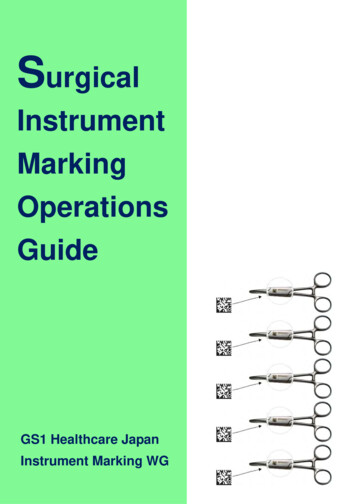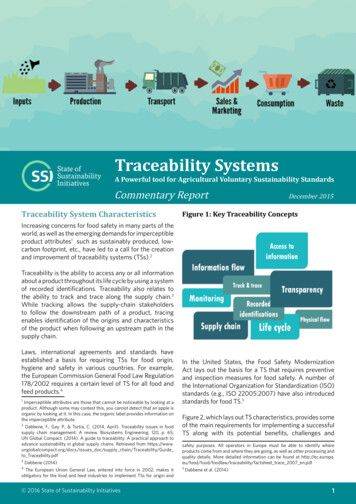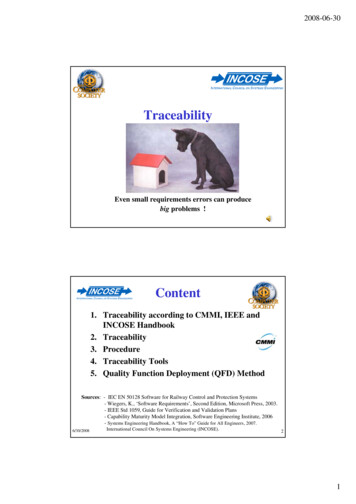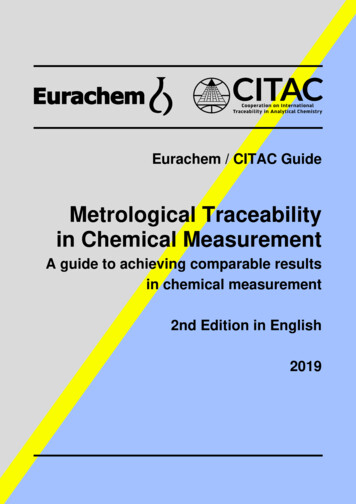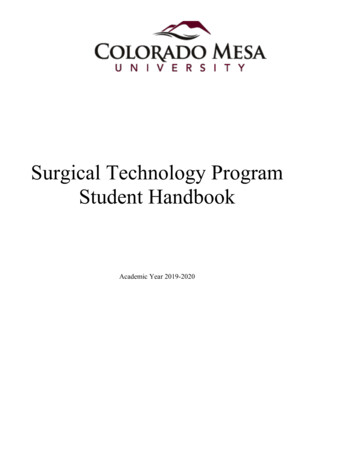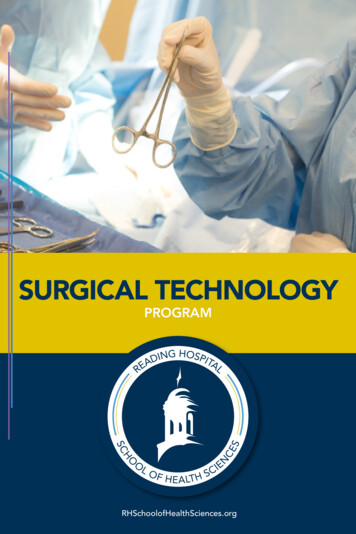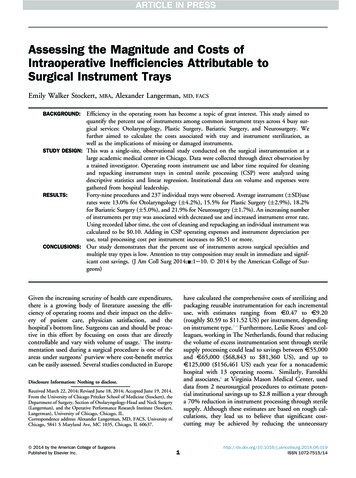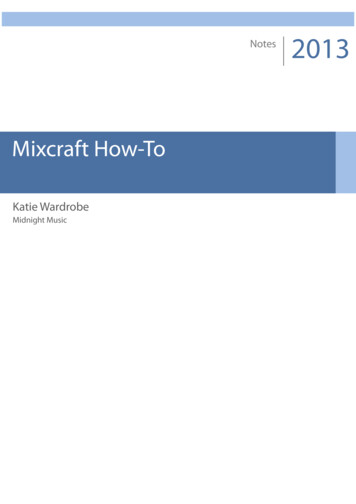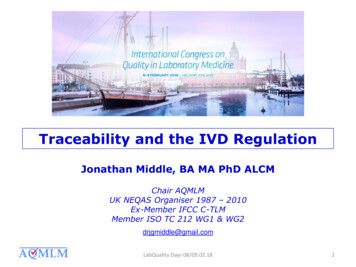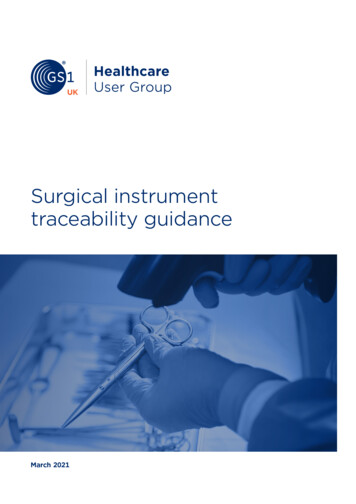
Transcription
Surgical instrumenttraceability guidanceMarch 2021
Surgical instrument traceability guidanceContributorsNameOrgansiationAndrew BentMedicines and Healthcare products Regulatory Agency (MHRA)Richard PriceUniversity Hospitals Plymouth NHS TrustRachael EllisHull University Teaching Hospitals NHS TrustJackie PomroyExternal consultantBen ClarkeGS1 UKPaul ReidGS1 UKJuliette NewGS1 UKCopyright informationThis document and all subject matter outlined within this document remain the copyright of GS1 UKLimited or contractors directly associated with it. Copyright covers all methodologies, analysis, approach,data modelling and project specifications outlined within this document, in part and in whole.About the Healthcare User Group (HUG)The HUG is made up of invited senior representatives from healthcare trade associations,providers, suppliers, solution and service companies, and other related organisations. Itspurpose is to promote the adoption of GS1 standards throughout UK health systems,its suppliers and partners, in line with necessary regulatory requirements.2
Surgical instrument traceability guidanceThe objectives of the group are to: Drive adoption of standards across the NHS, starting with acute trusts in England,and extending to health systems in Northern Ireland, Wales and ScotlandSupport implementation of standards to identify every person, product and placeCreate a sharing and learning environmentOffer support and advice to regional groups implementing our standardsBe responsive to the evolving healthcare environmentProvide feedback and advice on GS1 UK’s healthcare plans and activityWork with regulatory and other bodies, to support national and internationalstandards activityAct as the UK point of contact for the GS1 Global Healthcare Group and to providehealthcare related feedback into the Global Standards Management Process (GSMP)3
Surgical instrument traceability guidanceContents1. Introduction6ForewordBackgroundCurrent situation in the UKTarget audience67882. Approach9Principles of the GS1 System9Instrument and kit identification9Location identification9Patient identification10A common language10Gradual introduction to traceability123. InstrumentsInstrument identificationImplementation considerations for instrument identificationExamples of associated data for instrumentsData carriers for instruments4. ContainersContainer identificationImplementation considerations for containersExamples of associated data for containersData carriers for containers5. Procedure kitProcedure-kit identificationImplementation considerations for procedure-kit identificationExamples of associated data for procedure-kitsData carriers for procedure-kits13141415151516161617171919206. Loan kits207. Tracker/production labels20Tracker-label formatImplementation considerations for tracker labelsData carriers for tracker labels8. LocationsExamples of location useExamples of associated data for locations4132022222222234
Surgical instrument traceability guidance9. References2410. ixAppendixAppendixAppendix5A: Quick reference guideB: Comparison of GTIN and GIAIC: Creating Global Trade Item Numbers (GTINs)D: Creating Global Individual Asset Identifiers (GIAIs)E: Creating Global Location Numbers (GLNs)F: BarcodesG: Radio-frequency identification (RFID)H: Loan-set managment principle using GS1 standards26272830303133345
Surgical instrument traceability guidance1. Introduction1.1 ForewordGS1 is a not-for-profit, member-owned association, operating in more than 150 countries. The GS1vision is to enable organisations to speak the same language when it comes to identifying things,including people, products and places, capturing information at the point of interaction, sharing datathroughout a trust’s systems and processes from supplier to point of care/point of use.GS1 defines standards for healthcare in concert with the global healthcare industry. This includesglobally unique numbers, which are used in the identification of patients and caregivers, products,locations, and assets, anywhere within the global healthcare supply chain.These standards enable, among other things, the accurate scanning of medicines at the pharmacy,the recording of medical instruments used in a surgical procedure, and the location of equipment in ahospital that supports patient safety.GS1 understands the importance of having efficient and smooth-running supply chains for healthcare.Barcodes and identification technologies in hospitals are very important with huge patient-safetybenefits drawn from positively identifying patients, their interaction with caregivers, and the items usedin their treatment.Standards have been deployed successfully within healthcare around the globe to drive improvementsin patient care and safety, while at the same time reducing costs through improved efficiencies.The main benefit of implementing GS1 standards is improved patient safety, achieved through: Recording of information scanned at the point of useImproved traceabilityEnabling checks on usageFewer Never Events and critical errorsReduced administration errorsMore efficient processesBetter medicines managementSimplification and enhanced accuracy of order processing and receiptingGS1 standards are endorsed by the Department of Health and Social Care (DHSC), NHS Digital, NHSEngland, and the Medicines and Healthcare products Regulatory Agency (MHRA).66
Surgical instrument traceability guidance1.2 BackgroundDue to regulatory requirements – the publication of the both the Independent Medicines and MedicalDevices Safety (IMMDS) Review (the Cumberlege Review) and the Medicines and Medical Devices Act2021 – and the impact of Brexit, there is an increasing requirement to standardise and automate thetraceability of instruments, trays, and other products that are required to be sterilised.The aim of this document is to show how GS1 standards can be used to improve traceability andincrease the reliability of data for managing surgical instruments. As a result, trusts will benefit fromtangible financial and time savings. Most importantly, more accurate and efficient recall processes willdirectly improve patient safety.The Scan4Safety Evidence Report details financial benefits achieved from using GS1 standardsto manage surgical instruments and other medical products: Leeds Teaching Hospitals NHS Trust estimates it will save 84,411.07 each year on productrecalls thanks to the introduction of point-of-care scanningThrough scanning, Leeds Teaching Hospitals saved 83,548.41 from October 2016 to March2017, by standardising and rationalising the items in the surgical trays used for the fivemost common proceduresSince introducing Scan4Safety, University Hospitals of Derby and Burton NHS FoundationTrust has worked with its supplier and now uses pre-sterilised screws. These are scannedbefore use, meaning complete traceability of the items and no need to sterilise the trayagain. Each item costs about 50p more, but 36 is saved on sterilisation costsThis document explains which GS1 Identification Keys and GS1 data carriers are to be used across theinstrument lifecycle (see diagram below), and shows examples of the information that should be storedin master data and other systems (e.g. sterilisation management t all ition1. Purchase2. LoanCleaningDisposal1. Scrap2. Return to lender7
Surgical instrument traceability guidanceOnly once data can be automatically captured, stored, and shared across the instrument lifecycle, cantrue traceability be achieved.There are numerous regulations and recommendations that detail traceability requirements for surgicalinstruments, several of which specify the use of GS1 standards (see “other documents” in References).1.3 Current situation in the UK The DHSC and MHRA guidance is for hospitals to track instruments to at least tray levelDifferent hospitals have different tracking practices ranging from manual systems toautomated systemsSome track instruments at tray or group level while others track them at individualinstrument levelSeveral hospitals have implemented automatic identification and data capture (AIDC)supported systems, with some marking individual instrumentsFew systems used for medical-device management rely on each individual item beingidentified and marked in a way that would allow information on that instrument to becaptured as it is passed through the different processesQuite often, markings are done with proprietary numbers and barcodesIncreasing numbers of manufacturers mark instruments with a globally unique identifier tomeet Unique Device Identification (UDI) regulations, which are likely to be the GS1 GlobalTrade Item Number (GTIN), (see “other documents” in References)1.4 Target audienceThis document is a reference guide to implementing full traceability of surgical instruments in hospitals.It is intended for any hospital, including those that have centralised sterilisation service departments,hospitals that provide sterilisation services for other hospitals, and any other service providers whowant to implement GS1 standards to improve the traceability of surgical instruments and facilitateinteroperability across different parties and systems.It is important to recognise that the GS1 standards detailed in this document will enable traceabilityacross the associated healthcare landscape, beyond the more narrowly defined “dirty and clean”process. As such, any function involved in the procurement, storing, maintenance, clinical use, andrecall of surgical instruments, can benefit from their accurate identification using GS1 standards.This document is also intended for solution providers. In line with current drives to improve theconsistency, flexibility, and interoperability of technology across health and social care, all systemsdeveloped in house, commissioned, procured, or adopted should be “GS1 compliant” (as applicable).The GS1 UK compliance specification for the NHS provides guidance for buyers and commissioners onwhat that really means, and how to ensure that new systems are GS1 compliant.New and existing systems will need to utilise the appropriate GS1 Identification Key as either a primaryor secondary identifier for the required data elements based on the functionality and purpose of thesystem being considered.A key benefit of adopting GS1 standards is the ability to represent the different identification keysin standardised barcodes and radio-frequency identification (RFID) tags. Therefore, any systemsimplemented also need to be able to encode and/or decode compliant GS1 data carriers.If providers are unable to provide GS1 compliant systems in line with the recommendations in thisdocument, then full interoperability and traceability will be impossible.8
Surgical instrument traceability guidance2. Approach2.1 Principles of the GS1 SystemGS1 Identification Keys give companies efficient ways to access information about items across theirsystems and throughout their supply chains.They provide organisations with a way to assign standard identifiers to products, documents, physicallocations and more. As GS1 Identification Keys are globally unique, they can be shared betweenorganisations, enabling interoperability, and increasing supply-chain visibility for trading partners.These guidelines describe which of these identifiers should be used on which objects to enable datacapture during procurement, the sterilisation process and in theatre.For certain scenarios there will be more than one option presented with a supporting rationale. Thecourse of action taken by an implementor could be affected by their starting position, technology andsystems used, and their current processes.2.2 Instrument and kit identificationFor the traceability of surgical instruments and other items that need to be sterilised, organisationstypically have a choice between two GS1 identifiers that can be utilised across the process: Products:Assets:Global Trade Item Number (GTIN)Global Individual Asset Identifier (GIAI)The GS1 General Specifications (section 2.1.8 Medical devices) details that medical devices should beidentified by GTINs, whether it is the manufacturer or hospital marking the items, though the GIAI isalso compliant.These guidelines will explore the options in more detail and there is a table (Appendix B) which detailsthe features and considerations for the implementation of each identifier.2.3 Location identificationGlobal Location Numbers (GLNs), when used by trusts and their suppliers, enable the unambiguousidentification of physical and operational locations across the healthcare system.This means information can be collected and stored where an event occurs – whether this eventinvolves the dispensing of patient care, the sterilisation of instruments or the ordering and delivery ofgoods.These guidelines advocate the use of GLNs for surgical-instrument management and will provideexamples of how they could be allocated.9
Surgical instrument traceability guidance2.4 Patient identificationThe globally unique identification of the patient enables accurate and consistent information to becaptured and stored in the patient record at all relevant points along the patient pathway.The NHS Digital standard DCB1077, supports the accurate, timely and safer identification of NHSpatients, by defining how to encode the NHS approved patient identifiers into a GS1 DataMatrix forpatient identity bands. This utilises the Global Service Relation Number (GSRN) – a globally uniquecode for the identification of a care giver or care receiver.The barcode can be scanned at relevant points along the patient pathway, from admission through todischarge, recording events including patient observations, assessments, and medicines administration.Scanning a patient wristband eliminates the need for hand-written records, enabling accurate andreal-time capture of information to minimise risk to the patient. This should include the association ofGS1 identifiers relating to instruments and kits used in a theatre procedure that can be updated andstored within the patient’s medical rdLocationInstrumentPatient2.5 A common languageUsing GS1’s standardised, unique identification keys, interoperability can be facilitated across thehealthcare supply chain. By utilising a common language of identification keys and data carriers, partieswill be able to move physical products and share information about them without conflicting demandsor manual rGLNGLNTrust BSGTINGLNSGTIN/GIAISGTIN/GIAILoan set providerDecontaminationsuper centreGLNTrust ASGTINGLNGLNTheatreGLNSGTIN/GIAICSSD/SSD/CDUGLN10
Surgical instrument traceability guidanceGS1 standards should be used to identify surgical instruments and capture information about them,using data carriers for the following processes (non-exhaustive):SupplierProcessMeeting UDI requirementsGS1 identifierGTINIdentifying company and devices for MHRA Field Safety Notices (FSNs)GTIN and GLNPurchase to pay with customersGTIN and GLNManaging cataloguesInventory managementGTINGTIN and GLNProcurementProcessGS1 identifierOrdering productsGTIN and GLNIdentifying items that have been recalledGTINIdentifying locations of recalled itemsGTIN and GLNInventory managementGTIN and GLN11
Surgical instrument traceability guidanceCentral Sterile Services Department (CSSD)/Central Decontamination Unit (CDU)ProcessGS1 identifierReceiving unsterile loan tray setsItems being sent for repairReceiving unsterile surgical kits on loan from another trustGTIN/GIAI and GLNGTIN/GIAIGTIN/GIAI and GLNIdentifying items that are quarantined awaiting test results from a patient,approval for repair, replacement or decommissionGTIN/GIAINew inventory surgical kits and items awaiting quality approval process,which may include checking appropriate decontamination instructions for use(IFU), etcGTIN/GIAIProcesses including washroom and cleanroom activities, instrument assemblyand packing (IAP) and sterilisationGTIN/GIAI and GLN2.6 Gradual introduction of traceabilityWhilst the section above illustrates how GS1 standards can be fully adopted across the instrumentmanagement process, it is recognised that each trust or Health Board will have different requirementsfor the traceability of its instruments. Organisations will need to assess if complete traceability to theindividual instrument is necessary.Process and traceability requirements may include: Traceability of instruments up to the respective patientTraceability to the setup process and/or sterilisation processInstrument management (inventory, lifecycle management)Sterilisation services for other hospitalsThird-party service providers and loan kitsIt is recognised that some organisations may only be able to move to a full traceability system usingGS1 standards via a phased approach.12
Surgical instrument traceability guidanceWhile any sort of traceability system is better than none, limitations on implementing a partial or nonGS1 process are detailed below: Increased human error and processing time wherever manual data entry or stickers are usedLoss of interoperability across systems and parties wherever proprietary identifiers andbarcodes are usedLoss of traceability to trays and patients if individual instruments are not markedPaper versus electronic processing3. Instruments3.1 Instrument identificationGS1 is a UDI issuing agency/entity for many global regulations, including the US, EU, China, SouthKorea and Saudi Arabia, meaning that manufacturers supplying regulated medical devices to thesemarkets can use GS1 standards to implement UDI requirements.This means that manufacturers can identify their instruments and medical devices with a GTIN. Becauseit enables the identification of product types, the GTIN can be used throughout inventory-managementand supply-chain processes, including product recalls. By using a Serialised GTIN (SGTIN) to identifyindividual instruments, an extra level of granularity and traceability is achieved.However, it is recognised that a significant number of manufacturers are yet to implement UDI. In caseswhere the manufacturer has not marked an instrument and a trust wishes to, they should use theirown SGTIN (GS1 General Specifications, section 2.1.8 Medical devices). Supplementary items shouldalso be identified and marked with SGTINs. See the NHS Digital document, ISB 0108: AIDC: AutomaticIdentification and Data Capture which details instrument marking methods.Keydots encoding GTIN and Serial number (01)05022304000031(21)ABC123Alternatively, GIAIs can be used to identify instruments if the trust considers them to be “assets” ratherthan “products” and there is no requirement to identify them by type (e.g. for ordering by clinicians).The GIAI can then be used to manage the instrument throughout its lifecycle. However, it is importantto note that GIAIs are used to identify the “instance” of an instrument rather than the “class”, so anadditional identifier would be required to identify it by type.13
Surgical instrument traceability guidance3.2 Implementation considerations for instrument identification If an instrument has been marked with a manufacturer SGTIN, this should continue to beused by the trust (and cross-referenced to their own identifiers, if required)Manufacturer GTINs (if available) should be recorded in an appropriate database andmapped against trust-allocated identifiers (if allotted), in case of recallsThe format of the serial number is at the discretion of the party responsible, but it will needto adhere to the structure requirements specified in the GS1 General Specifications and TagData Standard (TDS)A serial number needs to be unique to each GTINIn GS1 standards, serial numbers are always to be understood as attributes of a GTIN. Onlythe combination of both guarantees uniqueness, so a serial number must never be read andprocessed without the GTINUnlike GTINs, GIAIs cannot be associated with Application Identifiers (AI), such as dates orthe batch in GS1 barcodesAn instrument should only ever be marked with a single GS1 identifier (GTIN or GIAI)3.3 Examples of associated data for instrumentsThe table below illustrates the type of data that would be held in different systems across a trust, forwhich the specified GS1 identifier would be used to reference.The systems expected to hold this data would include: Inventory-management systemsSterilisation-management systemsTheatre-management systemsElectronic patient record (EPR)The use of GS1 Identification Keys makes it possible to exchange and evaluate data between disparatesystems.Master data per type of instrumentData per instance of instrumentGTINSGTIN or GIAINameLink to procedure kit to which the instrument belongs(SGTIN)Type of instrumentGLN of maintenance supplierSizeDate of purchaseWeightDate of last maintenanceMaintenance cycleDate of last maintenanceGLN supplierNext maintenance dateEtc.Count of maintenanceEtc.14
Surgical instrument traceability guidance3.4 Data carriers for instruments Instruments should be marked with a GS1 DataMatrix and/or encoded in EPC/RFID tagSee appendices F and G for more detail4. Containers4.1 Container identificationIn these guidelines, “container” will be used as a catch-all term for the empty tray, basket or box inwhich instruments can be held.The sterilisation process and the link between the procedure kit and the patient can be controlledwithout identifying containers. However, it is possible that the containers may become relevant andneed to be distinguished from one another.To meet regulatory requirements (such as USFDA UDI, and EU MDR), manufacturers areincreasingly likely to have identified types ofcontainers with GTINs and individual containerswith SGTINs.These containers can also be considered assetsand can additionally be identified with a trustGIAI, if required. Where available, a supplier GTINshould be mapped against any trust-allocatedidentifier for the same item in a database, in caseof recalls.If a container has not already been marked bythe manufacturer, a trust can mark it with a GIAI.Tray tag encoding GIAI (8004)5012345678901234515
Surgical instrument traceability guidance4.2 Implementation considerations for containers If trusts do want to individually identify and mark containers as assets, it is important thatthey are not confused with any additional numbers and barcodes identifying the procedurekit. For example, a container could theoretically have two barcodes present: One identifying the complete procedure kit which contains instruments (SGTIN or GIAI) One identifying the container (GIAI)To reduce the chance of misidentification, there are three options:1. Preferred: the procedure kit is identified with a SGTIN on the tracker label rather thanon the container itself, and the container is marked with a GIAI identifying it as anasset. The procedure kit SGTIN identifies all its components, including the container.2. Typical of some legacy implementations: there is a GIAI on the container but thisidentifies the procedure tray (i.e. the container plus instruments), rather than thecontainer as an asset in its own right.3. Least desirable: the barcode that identifies the individual container is placed insidethe container itself, and the barcode which identifies the instance of the procedure kitis placed on the outside of the container (e.g. on a tag). This method could lead toconfusion and misidentification.4.3 Examples of associated data for containersMaster data per type of containerData per instance of containerGTINGIAIBrand nameGLN of maintenance supplierType of containerDate of purchaseSizeDate of last maintenanceWeightNext maintenance dateMaintenance cycleCount of maintenanceGLN of supplierEtc.Etc.4.4 Data carriers for containers Either the GS1-128 or GS1 DataMatrix can be usedSee appendices F and G for more detail16
Surgical instrument traceability guidance5. Procedure kit5.1 Procedure-kit identificationThe equipped procedure kit can consist of severalparts, each of which can be independentlyidentified: Procedure kit containing: One or more instrumentsA containerProcedure kit, consisting of surgical instruments in containersThe combination of the container and associated instruments can be considered a product. UsingGTINs to identify different types of procedure kit will enable improved supply-chain and inventoryprocesses, and facilitate information sharing between different parties and systems.Whoever assembles the kit is responsible for allocating the GTIN, for example, the trust, manufacturer,or loan-kit provider. The GTIN identifies the type of kit and is mapped to its components (e.g. typesof instruments contained) as master data. The GTIN enables that type of kit to be ordered (either byprocurement or in theatre) and enables better visibility of stock.Procedure kitGTINLeft-hip replacement05012345000008Right-hip replacement05012345000015While the GTIN identifies the type of kit – through the addition of a serial number, it is possible toidentify an instance of a kit. Through this SGTIN, it will then be possible to manage individual kitsthrough the decontamination process, linking kits to their specific components, and associating kitsused in theatre to the patient.Procedure kitGTINSerial numberLeft-hip replacement050123450000081Left-hip replacement050123450000082Right-hip replacement050123450000151Right-hip replacement05012345000015217
Surgical instrument traceability guidanceLegacy GS1 implementationsSome trusts that have already implemented GS1 standards for surgical-instrument traceability haveidentified and marked individual procedure kits as assets with GIAIs. This enables the management ofthe kits through their lifecycle. However, as GIAIs cannot be associated with the Application Identifiers(AI) required for the tracker labels (batch and date), the GIAIs would need to be mapped againstSGTINs in a one-to-one relationship in an appropriate database.Whilst this “double identification” may not be considered ideal, it is a compliant workaround whenkits need to be identified both as assets and as orderable items alongside additional sterilisationinformation.Procedure kitGIAIGTINSerial numberLeft-hip replacement5012345000ABC050123450000081Left-hip replacement5012345000DEF050123450000082Right-hip replacement5012345000GHI050123450000151Right-hip r-assembled procedure kitsDue to UDI regulations, manufacturersresponsible for the supply of reusable, finishedkits (e.g. Stryker, Smith & Nephew, Medtronic)are increasingly likely to have identified andmarked their products with GTINs and productioninformation, such as date, batch, and serialnumbers.It is recommended that trusts map their ownGTINs against the manufacturer’s GTINs in theappropriate databases. It is the trust’s GTINthat will then be encoded on the tracker labelalongside the associated sterilisation data.Manufacturer kit identifiers should be mapped totrust GTINs which can be encoded on tracking labelsThe recommended option for procedure kit identification and marking: The procedure kit is identified with an SGTIN. Following sterilisation, it is wrapped and theSGTIN is encoded on the tracker label.The container within is identified and marked with a GIAI (e.g. on an asset tag).Each instrument within the container is identified and marked with either an SGTIN or GIAI.The SGTIN which identifies the procedure kit can be used to retrieve information about all itscomponents (container and instruments).18
Surgical instrument traceability guidance5.2 Implementation considerations for procedure kit identification In GS1 standards, a GIAI cannot be associated with date or batch information, so if a trusthas allocated GIAIs to individual procedure kits, these identifiers would need be mapped toSGTINs to produce GS1-compliant tracker labelsIf a trust has not already allocated GIAIs to individual procedure kits, it is recommended thatthe type and instances of kits are identified by GTINs and SGTINsThe format of the serial number is at the discretion of the party responsible, but it will needto adhere to the data structure requirements specified in the GS1 General Specifications andTag Data Standard (TDS)A serial number needs to be unique to each GTINIn GS1 standards, serial numbers are always to be understood as attributes of a GTIN. Onlythe combination of both guarantees uniqueness, so a serial number must never be read andprocessed without the GTINIf a component is uniquely identified and is replaced like-for-like (e.g. due to it goingmissing or developing a fault), this would not require a new identifier to be allocated tothe kit – instead, the new details will be recorded in the kit’s associated master data in theappropriate databaseIf a component type is changed to another component type (e.g. from forceps 9.5” toforceps 10”), this would not require a new identifier to be allocated to the kit – instead, thenew details will be recorded in the kit’s associated master data in the appropriate database.Of course, if a significant component is changed and the trust needed to distinguishbetween the old and new versions of the procedure kit using the identification number andbarcode, a new GTIN could be allocated at the trust’s discretion.5.3 Examples of associated data for procedure kitsMaster data per type of procedure kitData per instance of procedure kitGTINGIAIBrand nameGLN of maintenance supplierType of containerDate of purchaseSizeDate of last maintenanceWeightNext maintenance dateMaintenance cycleCount of maintenanceGLN of supplierEtc.Etc.19
Surgical instrument traceability guidance5.6 Data
Surgical instrument traceability guidance 3 The objectives of the group are to: Drive adoption of standards across the NHS, starting with acute trusts in England, and extending to health systems in Northern Ireland, Wales and Scotland Support implementation
